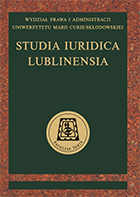Obrońca węzła małżeńskiego w świeckim prawie małżeńskim w Królestwie Polskim w XIX w.
Defender of the Marriage Bond in Secular Matrimonial Law in the Kingdom of Poland in the 19th Century
Author(s): Zdzisław ZarzyckiSubject(s): Christian Theology and Religion, Civil Law, 18th Century, 19th Century, WW II and following years (1940 - 1949), Canon Law / Church Law
Published by: Wydawnictwo Naukowe Uniwersytetu Marii Curie-Sklodowskiej
Keywords: defender of the marriage bond; divorce; marriage annulment; legal separation of marriage; the Kingdom of Poland; the Civil Code of the Kingdom of Poland;
Summary/Abstract: It was not until 1741, during the pontificate of Pope Benedict XIV, that the office of defender of the bond (defensor vinculi or defensor matrimonium) appeared in church matrimonial law. Next it was applied both to the matrimonial secular codifications in some European countries, as well as to partitioning legislation in our country. Until 1825, during the times of the Duchy of Warsaw and the Kingdom of Poland, in matrimonial cases there was applied the French legislation (the Napoleonic Code) which was of a highly secular character, and did not provide for the office of defender of the bond. Polish conservative factions, mainly the clergy of the Catholic Church, did not like such a state of affairs. There were postulated changes to matrimonial law regulations towards the confessional character, as well as implementation of the office of defender of the bond – following the ABGB pattern of 1811 in the Habsburg Monarchy – taking into account the domestic demands. The first attempts at reforms in this regard (1817–1818) ended in failure. Subsequent changes in marriage law, in the Kingdom of Poland, were implemented in 1825 under the name of the Civil Code of the Polish Kingdom. The Code would have allowed a defender of the bond to appear before a court in such cases as divorce, termination of marriage, or legal separation (“divorce from bed- -and-board”). Such a state of affairs was still not appreciated by the Catholic clergy who ultimately led to the adoption of a new marriage law in 1836. New law was of a highly confessional character and referred to jurisdictions and laws of individual religious organizations. These provisions, as amended, were in force in Poland (in the former Kingdom of Poland) until 31 December 1945.
Journal: Studia Iuridica Lublinensia
- Issue Year: 25/2016
- Issue No: 3
- Page Range: 1027-1044
- Page Count: 18
- Language: Polish

